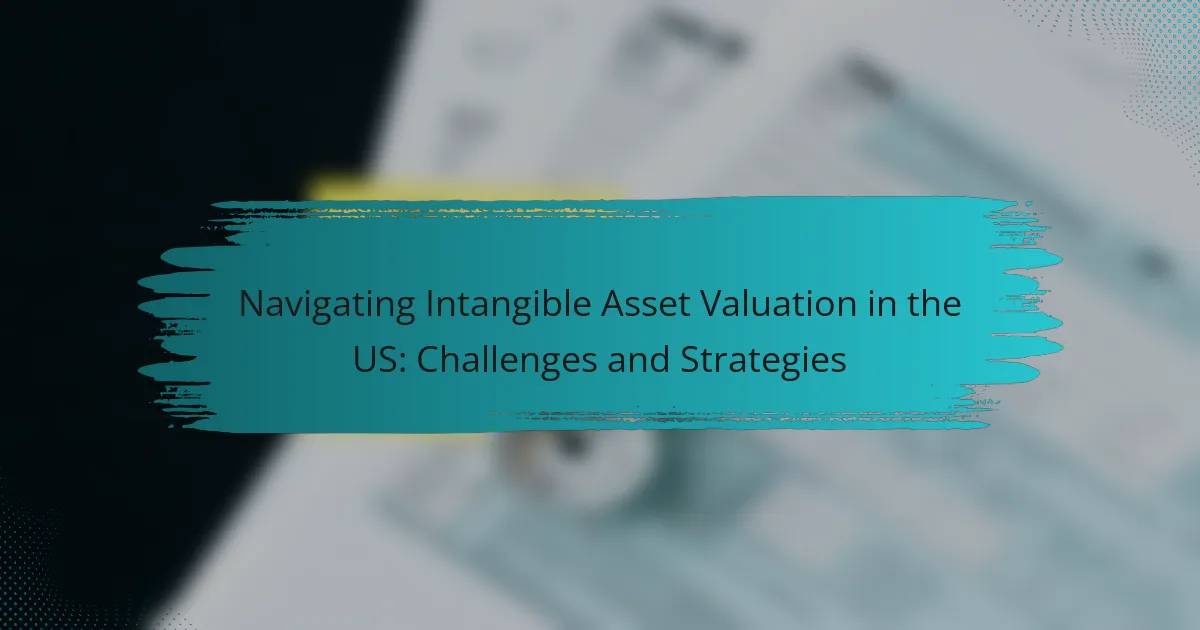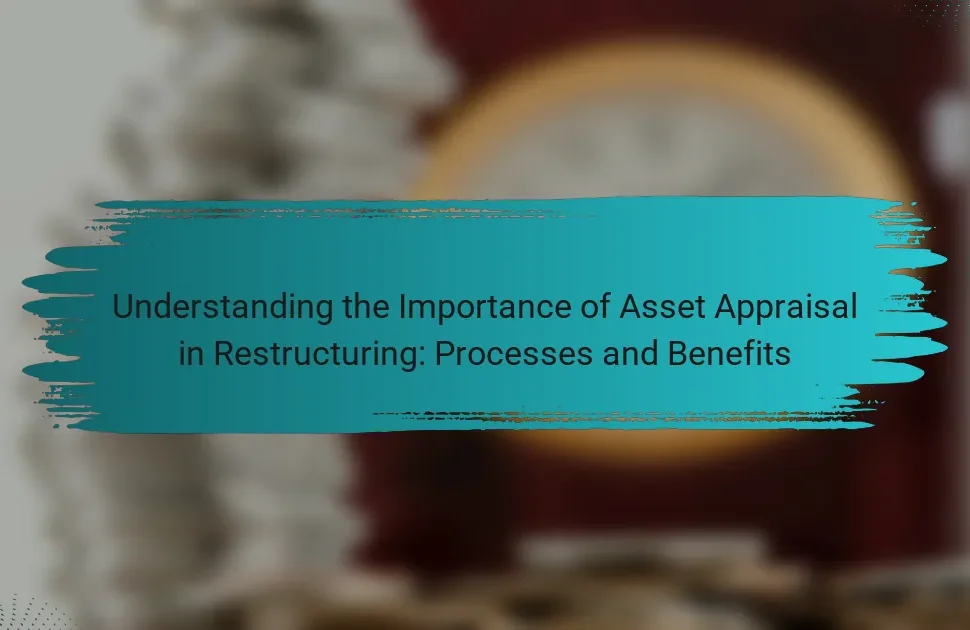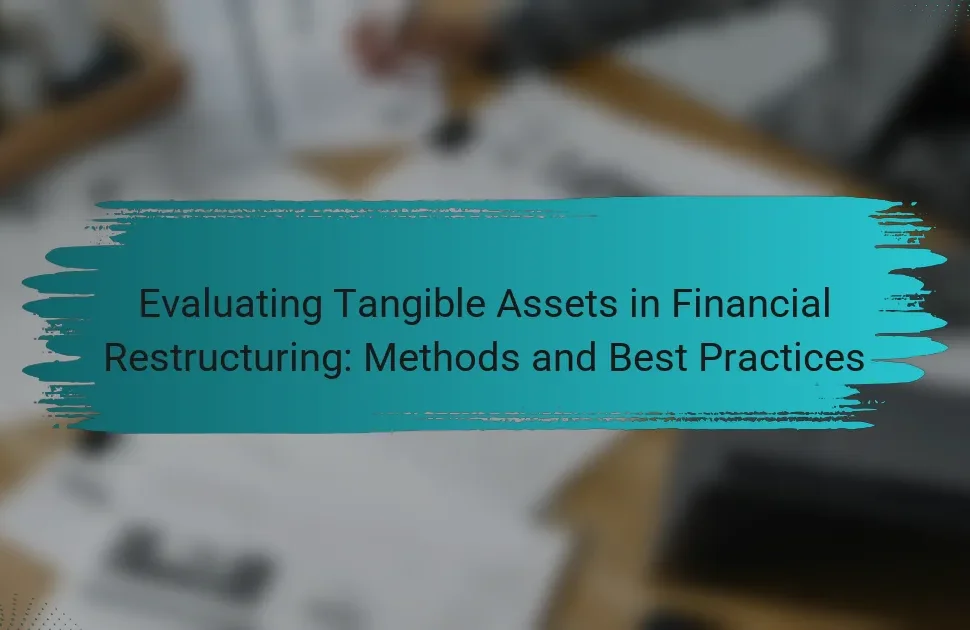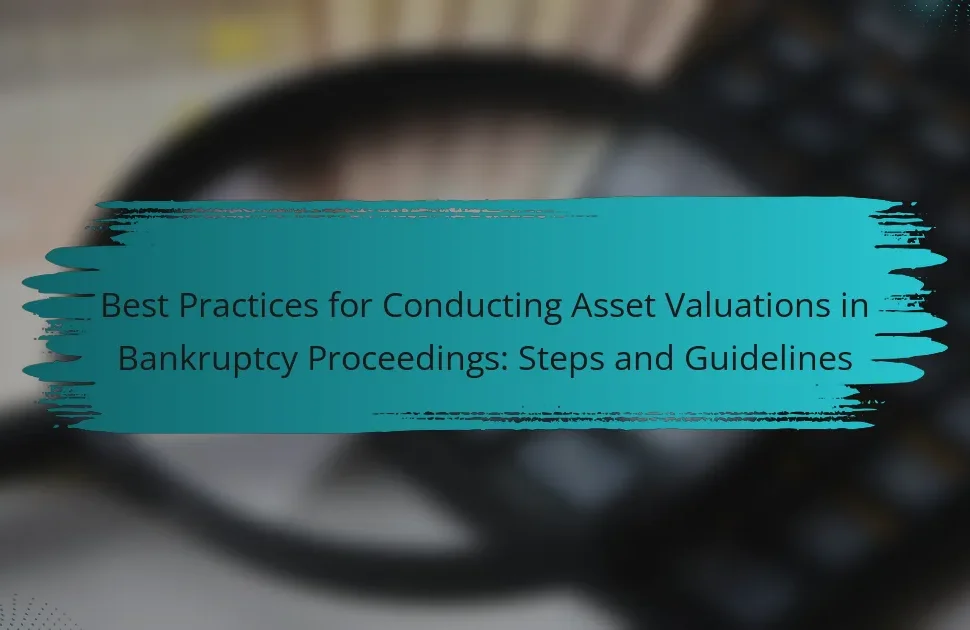Intangible assets are non-physical assets that contribute significant value to companies, including patents, trademarks, copyrights, and brand recognition. Their accurate valuation is essential as they can represent a large portion of a firm’s market value, influencing investment decisions, mergers, acquisitions, and financial reporting. This article explores the challenges and strategies involved in valuing intangible assets in the US, detailing approaches such as income, market, and cost methods, and highlighting the importance of expert appraisers. Understanding these valuation strategies is crucial for enhancing financial decision-making, compliance with accounting standards, and fostering stakeholder trust.
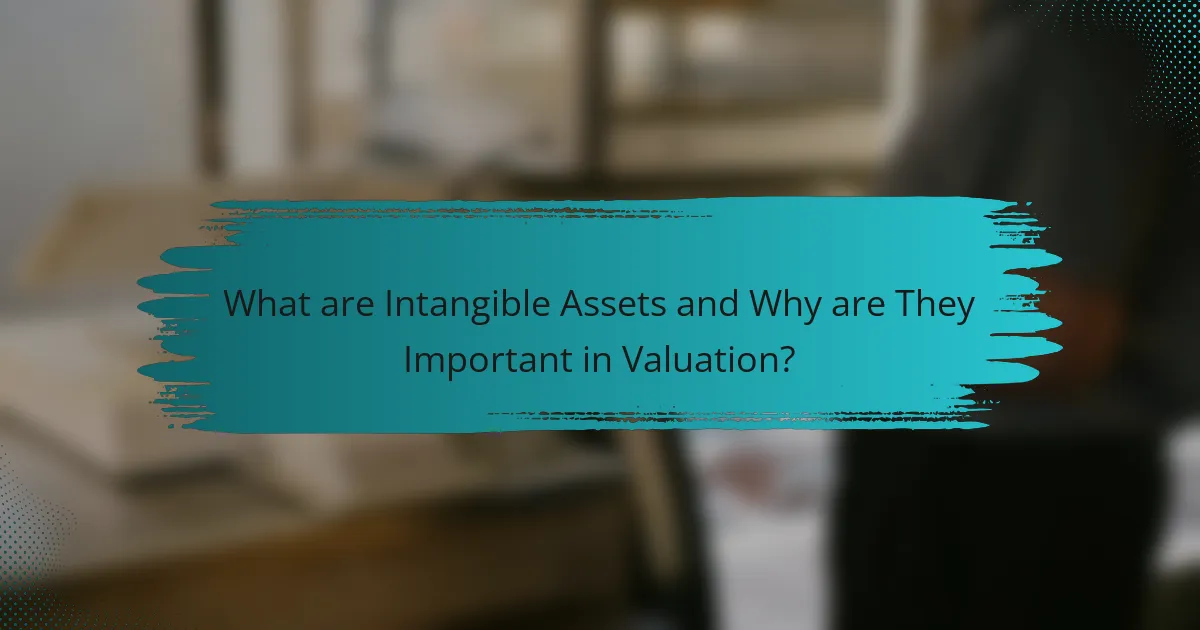
What are Intangible Assets and Why are They Important in Valuation?
Intangible assets are non-physical assets that provide value to a company. They include items like patents, trademarks, copyrights, and brand recognition. Intangible assets contribute significantly to a company’s overall worth. Their valuation is crucial because they can represent a substantial portion of a firm’s market value. For instance, in 2020, intangible assets accounted for over 80% of the market value of S&P 500 companies. Accurate valuation of these assets is essential for investment decisions, mergers, and acquisitions. It affects financial reporting and compliance with accounting standards. Understanding intangible assets helps stakeholders gauge a company’s true financial health.
How do intangible assets differ from tangible assets?
Intangible assets differ from tangible assets in that they are non-physical and cannot be touched or measured in a conventional sense. Intangible assets include intellectual property, brand recognition, and goodwill. Tangible assets, on the other hand, are physical items like machinery, buildings, and inventory. The valuation of intangible assets often relies on future economic benefits, unlike tangible assets which can be valued based on physical characteristics and market conditions. According to the Financial Accounting Standards Board (FASB), intangible assets are identifiable and can provide value over time, while tangible assets are subject to depreciation and physical wear. This distinction is crucial for financial reporting and asset management.
What types of intangible assets exist in the market?
Intangible assets in the market include intellectual property, brand recognition, goodwill, and proprietary technology. Intellectual property encompasses patents, copyrights, and trademarks. Brand recognition refers to the value derived from customer perception and loyalty. Goodwill represents the excess value of a business beyond its tangible assets. Proprietary technology includes unique processes or software that provide competitive advantages. These asset types are critical for valuation in business transactions and financial reporting. Their valuation methods can vary significantly based on market conditions and specific characteristics.
Why is the valuation of intangible assets critical for businesses?
The valuation of intangible assets is critical for businesses because it directly impacts financial reporting and decision-making. Accurate valuation helps in assessing the true worth of a company beyond tangible assets. Intangible assets often constitute a significant portion of a company’s total value. For instance, brands and patents can drive revenue and market competitiveness. Moreover, businesses require precise valuations for mergers, acquisitions, and investment purposes. Regulatory compliance also necessitates proper valuation to meet accounting standards. According to a study by the International Valuation Standards Council, intangible assets can account for up to 80% of a company’s market value. Therefore, understanding their worth is essential for strategic planning and stakeholder communication.
What challenges are faced in intangible asset valuation in the US?
Intangible asset valuation in the US faces several challenges. One major challenge is the lack of standardized measurement methods. Different valuation approaches can yield varying results for the same asset. Another challenge is the inherent uncertainty in estimating future cash flows. Intangible assets often rely on projections that can be difficult to predict accurately. Additionally, regulatory complexities can complicate valuations. Compliance with accounting standards such as ASC 350 requires careful consideration. Market conditions also impact the valuation process. Fluctuating economic environments can lead to inconsistent valuations over time. Finally, the subjective nature of certain intangible assets, like brand value, adds another layer of difficulty. These challenges highlight the complexities involved in accurately valuing intangible assets in the US.
How do regulatory frameworks impact intangible asset valuation?
Regulatory frameworks significantly influence intangible asset valuation. They establish guidelines for recognition, measurement, and reporting of these assets. For example, the Financial Accounting Standards Board (FASB) sets standards that dictate how companies should account for intangible assets. Compliance with these standards ensures consistency and transparency in financial reporting. Furthermore, regulations may affect the perceived risk associated with intangible assets. This, in turn, impacts their market value. Changes in regulations can lead to re-evaluations of asset worth. For instance, stricter intellectual property laws can enhance the value of patents and trademarks. Overall, regulatory frameworks shape both the methodology and outcomes of intangible asset valuation.
What common misconceptions exist about intangible asset valuation?
Common misconceptions about intangible asset valuation include the belief that all intangible assets can be easily quantified. Many people think that these assets have a straightforward monetary value. In reality, valuation often involves subjective assessments and varying methodologies. Another misconception is that intangible assets are not significant in financial reporting. However, they can represent a large portion of a company’s value, especially in tech and service industries. Furthermore, some believe that only large corporations own intangible assets. In fact, small businesses also possess valuable intangible assets like brand reputation and customer relationships. Lastly, there is a notion that intangible asset valuation is a one-time process. In truth, it requires ongoing assessment and adjustment to reflect market changes and business developments.
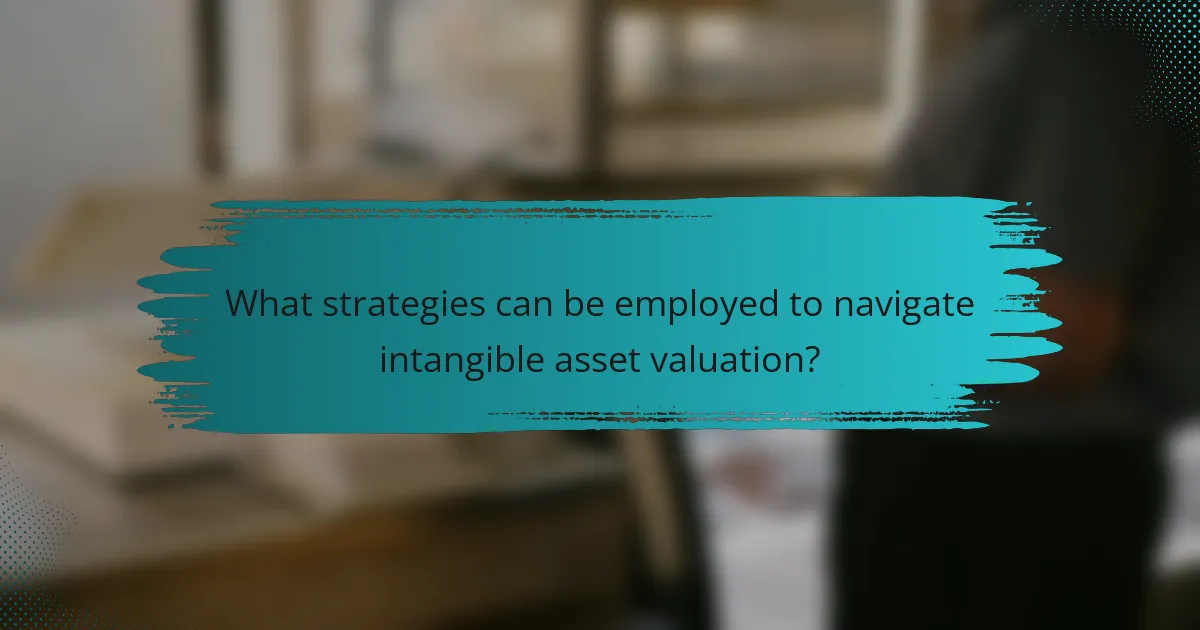
What strategies can be employed to navigate intangible asset valuation?
Strategies to navigate intangible asset valuation include using income, market, and cost approaches. The income approach calculates the present value of future cash flows attributable to the intangible asset. This method is effective for assets generating significant revenue projections. The market approach compares similar intangible assets to determine fair value. This approach relies on market data and can provide a benchmark for valuation. The cost approach assesses the expense incurred to create or replace the intangible asset. This method is useful when market data is scarce. Additionally, employing expert appraisers can enhance accuracy in valuation. Experts bring industry knowledge and experience to the process, ensuring robust assessments.
How can businesses effectively assess the value of their intangible assets?
Businesses can effectively assess the value of their intangible assets through several methods. One common approach is the income method, which estimates future cash flows generated by the asset. This involves projecting revenues and costs associated with the asset. Another method is the market approach, which compares the intangible asset to similar assets in the market. This requires access to relevant market data. The cost approach is also used, calculating the cost to recreate or replace the intangible asset.
Research shows that a combination of these methods often yields the most accurate valuation. For instance, a study by the International Valuation Standards Council highlights that using multiple approaches can mitigate risks associated with relying on a single method. Accurate assessment of intangible assets is crucial, as they represent a significant portion of overall business value.
What valuation methods are commonly used for intangible assets?
Commonly used valuation methods for intangible assets include the income approach, market approach, and cost approach. The income approach estimates the present value of future cash flows generated by the asset. This method is widely accepted for its focus on economic benefits. The market approach compares the asset to similar assets that have been sold in the market. This method provides a benchmark based on actual transactions. The cost approach calculates the value based on the costs incurred to create or replace the asset. Each method has its own application and relevance depending on the asset type. These methods are standardized in the industry, ensuring consistency in valuation practices.
How can companies choose the right valuation method for their needs?
Companies can choose the right valuation method by assessing their specific needs and circumstances. They should start by identifying the purpose of the valuation, such as for financial reporting or mergers and acquisitions. The choice of method may depend on the nature of the intangible assets being valued. Common methods include the income approach, market approach, and cost approach. Each method has its advantages and limitations. Companies should also consider the availability of data and the level of expertise required. Consulting with valuation professionals can provide insights tailored to the company’s situation. Ultimately, selecting the appropriate method involves balancing accuracy, relevance, and compliance with regulatory standards.
What role do professionals play in intangible asset valuation?
Professionals play a critical role in intangible asset valuation. They assess the value of non-physical assets like patents, trademarks, and goodwill. These experts apply various valuation methods, such as income, market, and cost approaches. Their expertise ensures accurate and compliant valuations, which are essential for financial reporting and mergers. Professionals also provide insights into market trends and economic factors that influence asset value. Their involvement helps businesses make informed decisions regarding investments and strategy. According to the International Valuation Standards Council, qualified professionals enhance the credibility of the valuation process.
What qualifications should a valuation expert possess?
A valuation expert should possess a relevant degree, such as in finance, accounting, or business. Professional certifications, like Certified Valuation Analyst (CVA) or Accredited in Business Valuation (ABV), are essential. Experience in financial analysis and valuation methodologies is crucial for expertise. Knowledge of industry standards and regulations enhances credibility. Strong analytical skills are necessary for accurate assessments. Communication skills are important for conveying complex information clearly. Continuous education in valuation practices ensures up-to-date knowledge. These qualifications collectively ensure a valuation expert can effectively assess intangible assets.
How can businesses find the right professionals for assistance?
Businesses can find the right professionals for assistance by leveraging multiple strategies. They should start by clearly defining their specific needs related to intangible asset valuation. This clarity helps in identifying the right expertise required. Next, businesses can utilize professional networks and platforms like LinkedIn to search for qualified professionals. Industry-specific forums and associations can also provide valuable resources for finding experienced individuals. Additionally, seeking recommendations from trusted colleagues or industry contacts can lead to reliable referrals. Finally, reviewing professional credentials and past case studies ensures the selected professionals have relevant experience and success in similar projects.
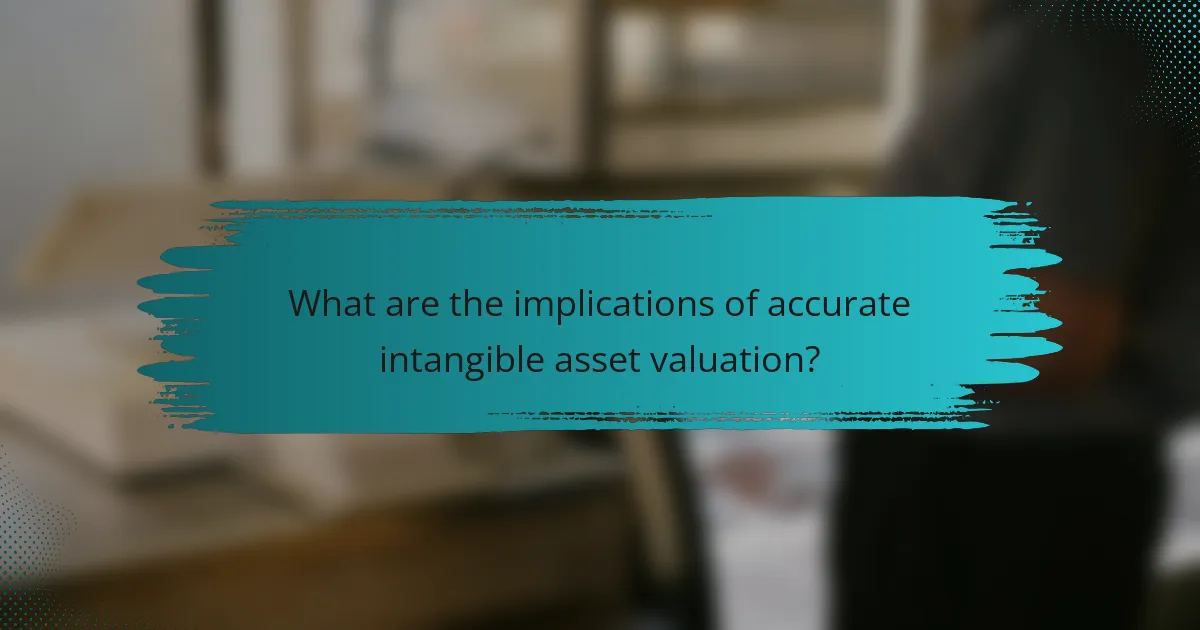
What are the implications of accurate intangible asset valuation?
Accurate intangible asset valuation has significant implications for businesses. It enhances financial reporting and improves decision-making. Companies can better assess their overall value. This valuation aids in mergers and acquisitions, providing clear insights into worth. It also impacts tax planning and compliance. Accurate valuation can lead to better investment strategies. Furthermore, it strengthens stakeholder trust and market confidence. According to the Financial Accounting Standards Board, proper valuation aligns with accounting standards, ensuring transparency.
How does accurate valuation influence financial reporting?
Accurate valuation significantly influences financial reporting by ensuring that assets and liabilities are presented fairly. This accuracy impacts key financial statements such as the balance sheet and income statement. When valuations are precise, stakeholders can make informed decisions based on reliable data. For example, the Financial Accounting Standards Board (FASB) emphasizes fair value measurement to enhance comparability and transparency in financial reporting. Additionally, accurate valuations help in compliance with regulations like the Generally Accepted Accounting Principles (GAAP). This compliance reduces the risk of financial misstatements and enhances investor confidence. Ultimately, precise valuation supports a true representation of a company’s financial health.
What are the potential risks of overvaluing or undervaluing intangible assets?
Overvaluing or undervaluing intangible assets can lead to significant financial risks. Overvaluation may result in inflated balance sheets, misleading investors, and potential regulatory scrutiny. Companies might face difficulties in securing financing if their asset valuations do not reflect reality. Conversely, undervaluation can lead to missed opportunities for growth and investment. It may also result in lower market capitalization, impacting shareholder value. Accurate valuation is crucial for strategic decision-making and maintaining investor confidence. According to a study by the International Valuation Standards Council, improper valuation can lead to financial misstatements and loss of credibility in the market.
What best practices can companies follow for effective intangible asset valuation?
Companies can follow several best practices for effective intangible asset valuation. First, they should establish a clear valuation purpose. This purpose guides the choice of methods and data used. Next, companies should use multiple valuation approaches. Common methods include the income, market, and cost approaches. Each method provides different insights into asset value.
Additionally, companies must gather accurate and relevant data. This data should reflect current market conditions and future economic expectations. Regular updates to valuations are also essential. This ensures that valuations remain relevant over time.
Lastly, involving experienced professionals in the valuation process is crucial. Their expertise can enhance accuracy and credibility. According to the International Valuation Standards Council, proper valuation practices lead to more reliable financial reporting and better decision-making.
How can companies maintain up-to-date valuations of their intangible assets?
Companies can maintain up-to-date valuations of their intangible assets by regularly conducting assessments and employing standardized valuation methods. Frequent reviews ensure that changes in market conditions and business performance are reflected. Utilizing frameworks such as the Income Approach or the Market Approach provides consistency in valuation. Engaging professional appraisers can enhance accuracy and credibility. Additionally, integrating financial reporting standards like IFRS or GAAP helps align valuations with regulatory requirements. Companies should also track industry trends and competitor performance for relevant benchmarking. This proactive approach supports informed decision-making and accurate financial reporting.
What tools and resources can assist in the valuation process?
Valuation process tools and resources include financial modeling software, market analysis reports, and valuation databases. Financial modeling software, such as Excel or specialized tools like ValuAdder, helps create detailed financial projections. Market analysis reports provide insights into industry trends and comparable company valuations. Valuation databases, such as PitchBook or Bloomberg, offer data on private and public company valuations. These resources enhance accuracy and reliability in valuation, facilitating informed decision-making.
The main entity of this article is intangible asset valuation, specifically focusing on its challenges and strategies within the US context. The article provides an overview of intangible assets, their significance in business valuation, and the differences between tangible and intangible assets. It discusses various types of intangible assets, the importance of accurate valuation for financial reporting and decision-making, and the challenges faced in the valuation process, including regulatory complexities and common misconceptions. Additionally, the article outlines effective strategies and best practices for navigating intangible asset valuation, emphasizing the role of professionals and the use of appropriate valuation methods to ensure accuracy and compliance.
